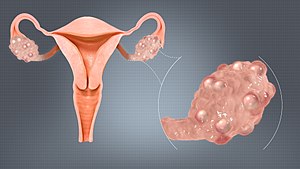പോളിസിസ്റ്റിക് ഓവറി
| Polycystic ovary syndrome | |
|---|---|
| മറ്റ് പേരുകൾ | Hyperandrogenic anovulation (HA),[1] Stein-Leventhal syndrome[2] |
 | |
| A polycystic ovary | |
| സ്പെഷ്യാലിറ്റി | Gynecology, Endocrinology |
| ലക്ഷണങ്ങൾ | Irregular menstrual periods, heavy periods, excess hair, acne, pelvic pain, difficulty getting pregnant, patches of thick, darker, velvety skin[3] |
| സങ്കീർണത | Type 2 diabetes, obesity, obstructive sleep apnea, heart disease, mood disorders, endometrial cancer[4] |
| കാലാവധി | Long term[5] |
| കാരണങ്ങൾ | Genetic and environmental factors[6][7] |
| അപകടസാധ്യത ഘടകങ്ങൾ | Obesity, not enough exercise, family history[8] |
| ഡയഗ്നോസ്റ്റിക് രീതി | Based on anovulation, high androgen levels, ovarian cysts[4] |
| ഡിഫറൻഷ്യൽ ഡയഗ്നോസിസ് | Adrenal hyperplasia, hypothyroidism, high blood levels of prolactin[9] |
| Treatment | Weight loss, exercise[10][11] |
| മരുന്ന് | Birth control pills, metformin, anti-androgens[12] |
| ആവൃത്തി | 2% to 20% of women of childbearing age[8][13] |
പോളിസിസ്റ്റിക് ഓവറി അഥവാ പോളിസിസ്റ്റിൻ ഓവറി സിൻഡ്രോം അല്ലെങ്കിൽ പോളിസിസ്റ്റിക് ഓവറി ഡിസീസ് എന്നത് എറ്റവും കൂടുതലായി കാണപ്പെടുന്ന അന്തർഗ്രന്ഥി അസുഖമാണ്. ഇംഗ്ലീഷ്: Polycystic ovary syndrome, or PCOS [14] നിരവധി സിസ്റ്റുകൾ അഥവാ മുഴകൾ അണ്ഡാശയത്തിൽ കാണപ്പെടുന്ന അവസ്ഥയാണിത്. ഇത് സ്ത്രീകളെ ആഴത്തിൽ ബാധിക്കുന്ന അന്തർഗ്രന്ഥി അസുഖത്തിന്റെ ബാഹ്യമായ ലക്ഷണങ്ങൾ മാത്രമാണ്.[15]
റഫറൻസുകൾ[തിരുത്തുക]
- ↑ Kollmann M, Martins WP, Raine-Fenning N (2014). "Terms and thresholds for the ultrasound evaluation of the ovaries in women with hyperandrogenic anovulation". Human Reproduction Update. 20 (3): 463–464. doi:10.1093/humupd/dmu005. PMID 24516084.
- ↑ Legro RS (2017). "Stein-Leventhal syndrome". Encyclopedia Britannica. Retrieved 30 January 2021.[better source needed]
- ↑ ഉദ്ധരിച്ചതിൽ പിഴവ്: അസാധുവായ
<ref>ടാഗ്;NICHD What are the symptoms of PCOS?എന്ന പേരിലെ അവലംബങ്ങൾക്ക് എഴുത്തൊന്നും നൽകിയിട്ടില്ല. - ↑ 4.0 4.1 "Polycystic Ovary Syndrome (PCOS): Condition Information". National Institute of Child Health and Human Development. January 31, 2017. Retrieved 19 November 2018.
- ↑ ഉദ്ധരിച്ചതിൽ പിഴവ്: അസാധുവായ
<ref>ടാഗ്;NICHD Is there a cure for PCOS?എന്ന പേരിലെ അവലംബങ്ങൾക്ക് എഴുത്തൊന്നും നൽകിയിട്ടില്ല. - ↑ ഉദ്ധരിച്ചതിൽ പിഴവ്: അസാധുവായ
<ref>ടാഗ്;De2016എന്ന പേരിലെ അവലംബങ്ങൾക്ക് എഴുത്തൊന്നും നൽകിയിട്ടില്ല. - ↑ ഉദ്ധരിച്ചതിൽ പിഴവ്: അസാധുവായ
<ref>ടാഗ്;Endo2006എന്ന പേരിലെ അവലംബങ്ങൾക്ക് എഴുത്തൊന്നും നൽകിയിട്ടില്ല. - ↑ 8.0 8.1 ഉദ്ധരിച്ചതിൽ പിഴവ്: അസാധുവായ
<ref>ടാഗ്;NICHD What causes PCOS?എന്ന പേരിലെ അവലംബങ്ങൾക്ക് എഴുത്തൊന്നും നൽകിയിട്ടില്ല. - ↑ ഉദ്ധരിച്ചതിൽ പിഴവ്: അസാധുവായ
<ref>ടാഗ്;NICHD How do health care providers diagnose PCOS?എന്ന പേരിലെ അവലംബങ്ങൾക്ക് എഴുത്തൊന്നും നൽകിയിട്ടില്ല. - ↑ ഉദ്ധരിച്ചതിൽ പിഴവ്: അസാധുവായ
<ref>ടാഗ്;Mor2015എന്ന പേരിലെ അവലംബങ്ങൾക്ക് എഴുത്തൊന്നും നൽകിയിട്ടില്ല. - ↑ ഉദ്ധരിച്ചതിൽ പിഴവ്: അസാധുവായ
<ref>ടാഗ്;Gia2009എന്ന പേരിലെ അവലംബങ്ങൾക്ക് എഴുത്തൊന്നും നൽകിയിട്ടില്ല. - ↑ ഉദ്ധരിച്ചതിൽ പിഴവ്: അസാധുവായ
<ref>ടാഗ്;NIH2014Tx1എന്ന പേരിലെ അവലംബങ്ങൾക്ക് എഴുത്തൊന്നും നൽകിയിട്ടില്ല. - ↑ ഉദ്ധരിച്ചതിൽ പിഴവ്: അസാധുവായ
<ref>ടാഗ്;Lub2013എന്ന പേരിലെ അവലംബങ്ങൾക്ക് എഴുത്തൊന്നും നൽകിയിട്ടില്ല. - ↑ Goodman NF, Cobin RH, Futterweit W, Glueck JS, Legro RS, Carmina E (November 2015). "American Association of Clinical Endocrinologists, American College of Endocrinology, and androgen excess and PCOS society disease state clinical review: guide to the best practices in the evaluation and treatment of polycystic ovary syndrome-part 1". Endocrine Practice. 21 (11): 1291–1300. doi:10.4158/EP15748.DSC. PMID 26509855.
- ↑ Dunaif A, Fauser BC (November 2013). "Renaming PCOS--a two-state solution". The Journal of Clinical Endocrinology and Metabolism. 98 (11): 4325–4328. doi:10.1210/jc.2013-2040. PMC 3816269. PMID 24009134.
Around 20% of European women have polycystic ovaries (the prevalence is even higher in some other populations) but approximately two-thirds of these women do not have PCOS
